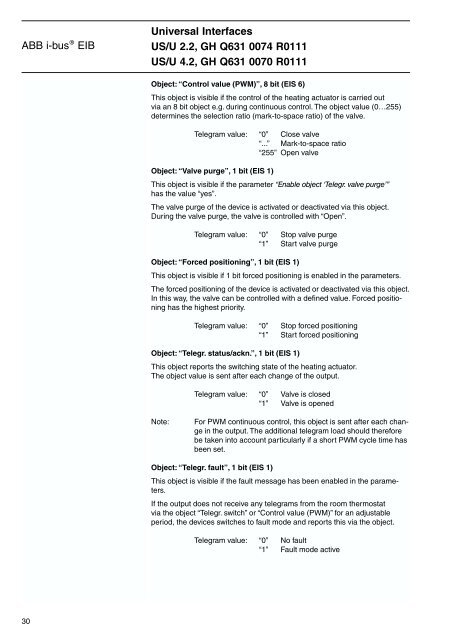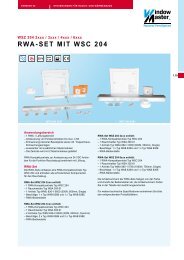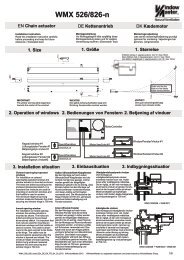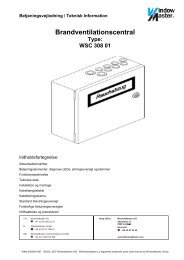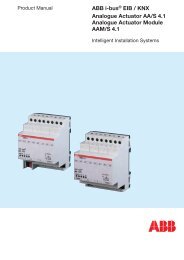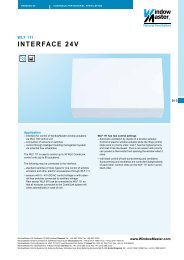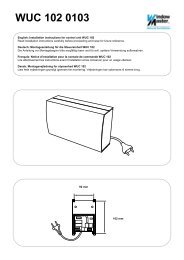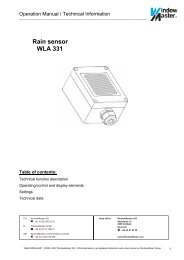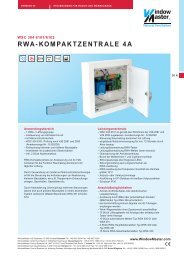ABB i-bus® EIB Universal Interfaces US/U 4.2 US/U ... - WindowMaster
ABB i-bus® EIB Universal Interfaces US/U 4.2 US/U ... - WindowMaster
ABB i-bus® EIB Universal Interfaces US/U 4.2 US/U ... - WindowMaster
You also want an ePaper? Increase the reach of your titles
YUMPU automatically turns print PDFs into web optimized ePapers that Google loves.
<strong>ABB</strong> i-bus ® <strong>EIB</strong><br />
<strong>Universal</strong> <strong>Interfaces</strong><br />
<strong>US</strong>/U 2.2, GH Q631 0074 R0111<br />
<strong>US</strong>/U <strong>4.2</strong>, GH Q631 0070 R0111<br />
Object: “Control value (PWM)”, 8 bit (EIS 6)<br />
This object is visible if the control of the heating actuator is carried out<br />
via an 8 bit object e.g. during continuous control. The object value (0…255)<br />
determines the selection ratio (mark-to-space ratio) of the valve.<br />
Telegram value: “0” Close valve<br />
“...” Mark-to-space ratio<br />
“255” Open valve<br />
Object: “Valve purge”, 1 bit (EIS 1)<br />
This object is visible if the parameter “Enable object ‘Telegr. valve purge’”<br />
has the value “yes”.<br />
The valve purge of the device is activated or deactivated via this object.<br />
During the valve purge, the valve is controlled with “Open”.<br />
Telegram value: “0” Stop valve purge<br />
“1” Start valve purge<br />
Object: “Forced positioning”, 1 bit (EIS 1)<br />
This object is visible if 1 bit forced positioning is enabled in the parameters.<br />
The forced positioning of the device is activated or deactivated via this object.<br />
In this way, the valve can be controlled with a defined value. Forced positioning<br />
has the highest priority.<br />
Telegram value: “0” Stop forced positioning<br />
“1” Start forced positioning<br />
Object: “Telegr. status/ackn.”, 1 bit (EIS 1)<br />
This object reports the switching state of the heating actuator.<br />
The object value is sent after each change of the output.<br />
Telegram value: “0” Valve is closed<br />
“1” Valve is opened<br />
Note:<br />
For PWM continuous control, this object is sent after each change<br />
in the output. The additional telegram load should therefore<br />
be taken into account particularly if a short PWM cycle time has<br />
been set.<br />
Object: “Telegr. fault”, 1 bit (EIS 1)<br />
This object is visible if the fault message has been enabled in the parameters.<br />
If the output does not receive any telegrams from the room thermostat<br />
via the object “Telegr. switch” or “Control value (PWM)” for an adjustable<br />
period, the devices switches to fault mode and reports this via the object.<br />
Telegram value: “0” No fault<br />
“1” Fault mode active<br />
30


